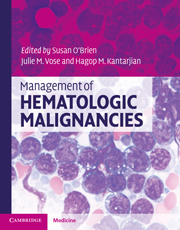Book contents
- Frontmatter
- Contents
- List of contributors
- 1 Molecular pathology of leukemia
- 2 Management of acute myeloid leukemia
- 3 Treatment of acute lymphoblastic leukemia (ALL) in adults
- 4 Chronic myeloid leukemia
- 5 Chronic lymphocytic leukemia/small lymphocytic lymphoma
- 6 Myelodysplastic syndromes (MDS)
- 7 Hairy cell leukemia
- 8 Acute promyelocytic leukemia: pathophysiology and clinical results update
- 9 Myeloproliferative neoplasms
- 10 Monoclonal gammopathy of undetermined significance, smoldering multiple myeloma, and multiple myeloma
- 11 Amyloidosis and other rare plasma cell dyscrasias
- 12 Waldenstrom's macroglobulinemia/lymphoplasmacytic lymphoma
- 13 WHO classification of lymphomas
- 14 Molecular pathology of lymphoma
- 15 International staging and response criteria for lymphomas
- 16 Treatment approach to diffuse large B-cell lymphomas
- 17 Mantle cell lymphoma
- 18 Follicular lymphomas
- 19 Hodgkin lymphoma: epidemiology, diagnosis, and treatment
- 20 Treatment approaches to MALT/marginal zone lymphoma
- 21 Peripheral T-cell lymphomas
- 22 Mycosis fungoides and Sézary syndrome
- 23 Central nervous system lymphoma
- 24 HIV-related lymphomas
- 25 Lymphoblastic lymphoma
- 26 Burkitt lymphoma
- Index
- References
24 - HIV-related lymphomas
Published online by Cambridge University Press: 10 January 2011
- Frontmatter
- Contents
- List of contributors
- 1 Molecular pathology of leukemia
- 2 Management of acute myeloid leukemia
- 3 Treatment of acute lymphoblastic leukemia (ALL) in adults
- 4 Chronic myeloid leukemia
- 5 Chronic lymphocytic leukemia/small lymphocytic lymphoma
- 6 Myelodysplastic syndromes (MDS)
- 7 Hairy cell leukemia
- 8 Acute promyelocytic leukemia: pathophysiology and clinical results update
- 9 Myeloproliferative neoplasms
- 10 Monoclonal gammopathy of undetermined significance, smoldering multiple myeloma, and multiple myeloma
- 11 Amyloidosis and other rare plasma cell dyscrasias
- 12 Waldenstrom's macroglobulinemia/lymphoplasmacytic lymphoma
- 13 WHO classification of lymphomas
- 14 Molecular pathology of lymphoma
- 15 International staging and response criteria for lymphomas
- 16 Treatment approach to diffuse large B-cell lymphomas
- 17 Mantle cell lymphoma
- 18 Follicular lymphomas
- 19 Hodgkin lymphoma: epidemiology, diagnosis, and treatment
- 20 Treatment approaches to MALT/marginal zone lymphoma
- 21 Peripheral T-cell lymphomas
- 22 Mycosis fungoides and Sézary syndrome
- 23 Central nervous system lymphoma
- 24 HIV-related lymphomas
- 25 Lymphoblastic lymphoma
- 26 Burkitt lymphoma
- Index
- References
Summary
Epidemiology/etiology
Ever since the beginning of the HIV/AIDS pandemic, it has been recognized that in addition to the increased risk of opportunistic and other infections, the incidence of malignancy is much greater in people with HIV/AIDS (PWHA) than that of the general population. This risk is likely a direct result of the immune dysfunction from chronic HIV infection, though concomitant viral infections including Epstein–Barr virus (EBV), human herpesvirus 8 (HHV-8), and human papilloma virus (HPV) also play a role. While the incidence of cancers is increased both for PWHA and immunosuppressed organ transplant patients, the risk of non-Hodgkin (NHL) and Hodgkin (HL) lymphomas appears to be significantly greater in the setting of HIV/AIDS compared to the transplant population.
This risk of NHL is 25- to 200-fold increased in PWHA compared to those without HIV, and risk appears to increase with duration of HIV infection as well as with lower CD4 counts. The risk of HL, while not considered an AIDS-defining illness (ADI) by the Centers for Disease Control, is increased by about 5- to 15-fold in PWHA; however, its incidence is decreased with lower CD4 counts. Since the widespread introduction of highly active antiretroviral therapy (HAART) in the mid-1990s, the incidence of ADIs and mortality among PWHA has decreased dramatically and many studies have reported an increase in the proportion of ADIs attributable to HIV-related lymphomas (HRL).
- Type
- Chapter
- Information
- Management of Hematologic Malignancies , pp. 462 - 486Publisher: Cambridge University PressPrint publication year: 2010



